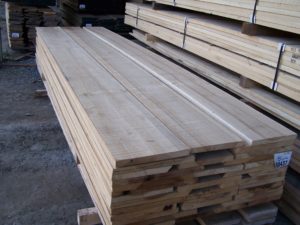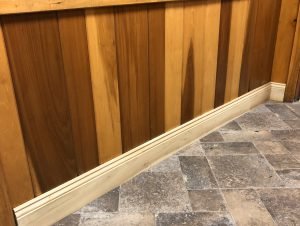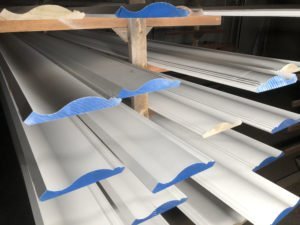Lirodendron tulipifera

Poplar wood, lacking bold coloration or an exciting grain pattern, doesn’t often get the respect we feel it deserves. Poplar is about half as hard as Red Oak so it is quite easy to work. This makes it one of the most popular hardwood species for mouldings and linear millwork. The even grain and naturally smooth surface makes it an excellent candidate for painting as well.
Using Poplar is easy since every lumber yard and millwork house will have a supply on hand. The Poplar tree is widespread across all of North America and Europe, and it grows very rapidly and to large sizes, meaning it’s very easy to sustain. This means a wide variety of widths, thicknesses, and lengths can be easily had anywhere in the country. However, since Poplar is used primarily for mouldings, most yards will stock it in 3/4″ thicknesses and narrower widths which are common for those mouldings. This does not mean, however, that wide boards are not possible to obtain, and usually it is just a matter of asking.
Staining and Painting Poplar
Poplar lumber is quite often called a “paint grade wood.” Its lighter color and lack of graining means it can easily be painted without the grain showing through. At the same time, this even grain means that it takes a stain really well and can be colored to look like a wide variety of other species. The uniformity of the wood will result in even absorption of the stains and no blotchy colors. Because the wood is often painted or used in secondary applications where it isn’t visible, it is very easy to find wide, clear sections of Poplar for a variety of uses. At J. Gibson McIlvain lumber company, we usually have a large supply of Poplar wood in stock, and due to the wood’s high availability and locality, we can very quickly obtain new stock and kiln dry it for a stable product.
Is Poplar a Hardwood?

Poplar lumber is pretty soft and very easy to work. But botanically speaking, it is a hardwood – meaning it is a deciduous tree. But it is highly stable, easily available in width and length, and takes paint and stain famously well. However, using Poplar as a stain grade species is often overlooked. Some will call Poplar wood “poor man’s Cherry,” as it oxidizes over time to a much darker shade of brown. In fact, as shown in the image, there is a stark contrast between freshly milled Poplar lumber and the aged material. It is just another option to consider before you cover up the agreeable grain with paint. The combined factors of low cost and high availability in a variety of widths and thicknesses make Poplar an outstanding secondary or paint-grade wood that is perfect for interior building or furniture applications.
Poplar Lumber Specifications
| Character | Green | Dry | Units |
| Bending Strength | 6000 | 10100 | psi |
| Crushing Strength | 270 | 500 | psi |
| Max Crushing Strength | 2660 | 5540 | psi |
| Impact Strength | 26 | 24 | inches |
| Stiffness | 1220 | 1580 | 1000 psi |
| Work to Maximum Load | 8 | 9 | in-lbs/in3 |
| Hardness (Janka) | – | 540 | lbs |
| Shearing Strength | – | 1190 | psi |
| Specific Gravity | 0.40 | 0.42 | – |
| Weight | 46 | 30 | lbs/ft3 |
| Radial Shrinkage | – | 5 | % |
| Tangential Shrinkage | – | 8 | % |
| Volumetric Shrinkage | – | 13 | % |
Poplar Wood Applications


Poplar is most commonly used, however, in architectural millwork, because it is soft enough to be gentle on cutting tools, yet hard enough to retain details. The fine pores finish very well, taking an even and smooth coat of paint, primer, varnish, or shellac. At the same
In general, when the final project is to be stained or painted, there usually is no better choice than Poplar.


